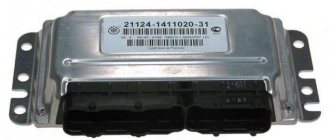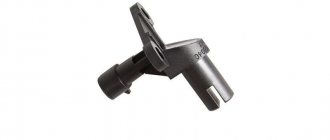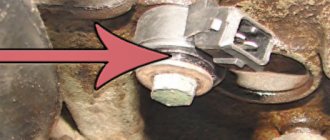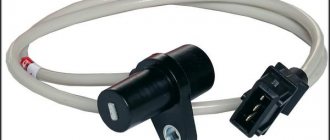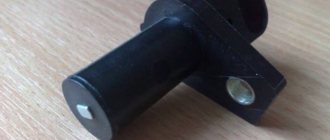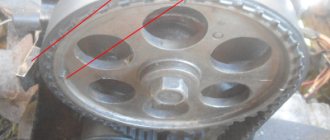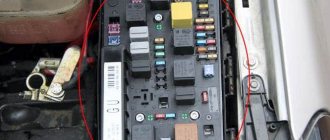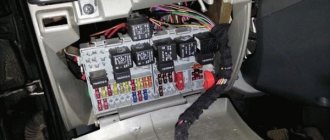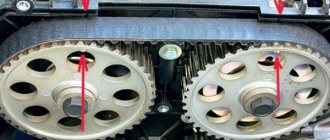Hello everyone, I apologize that I completely stole this from someone, but when I was looking for information on the speed sensor, this murzilka helped me a lot.
Sensors (VAZ injector)
Any injection system (VAZ 2108, 2109, 2110, 2111, 2112, 2113, 2114, 2115, NIVA...) includes a set of sensors for collecting information about the condition and operating mode of the engine.
MASS AIR FLOW SENSOR (MAF) VAZ
The VAZ mass air flow sensor (MAF) is installed on the air filter housing. The mass air flow sensor (MAF) measures the amount of air taken in by the engine in kg/hour. The device is quite reliable. The main enemy is moisture sucked in along with the air. The main malfunction of the mass air flow sensor (MAF) is an overestimation of readings at low speeds by 10 - 20%. This leads to unstable engine operation at idle, stopping after power modes, and possible problems with starting. Understating the readings of the mass air flow sensor (MAF) in power modes leads to “dullness” of the engine and increased fuel consumption. Typical idle air consumption is 8-10 kg/hour. At 3000 rpm - 28-32 kg/hour. Read more…
Price: 2000 rubles (Cost of the sensor including installation and performance testing)
THROTTLE POSITION SENSOR VAZ
The VAZ throttle position sensor is installed on the side of the throttle pipe on the same axis as the throttle valve drive. The throttle position sensor takes readings from the position of the gas pedal. The main enemies of the throttle position sensor are the sensor manufacturer and engine washers. The lifespan of the throttle position sensor is completely unpredictable. Malfunctions in the operation of the throttle position sensor are manifested in increased idle speed, jerks and dips at low loads. Read more…
Price: 250 rubles (Cost of the sensor including installation and performance testing)
COOLANT TEMPERATURE SENSOR VAZ
The VAZ coolant temperature sensor is installed between the block head and the thermostat. The coolant temperature sensor has two contacts (unlike the single-contact temperature sensor for the instrument panel, which is located next to it, do not confuse it). The main functional purpose of the coolant temperature sensor is akin to the “choke” on the carburetor - the colder the engine, the richer the fuel mixture. Structurally, the coolant temperature sensor is a thermistor (resistor), the resistance of which varies depending on the temperature. Typical values 100 g. — 177 Ohm, 25 gr. — 2796 Ohm, 0 gr. — 9420 Ohm, — 20 gr. — 28680 Ohm. Coolant temperature affects almost all engine management characteristics. The coolant temperature sensor is very reliable. The main malfunctions are a violation of the electrical contact inside the sensor, a violation of the insulation, or a break in the wires near the sensor due to a dangling throttle cable. Failure of the coolant temperature sensor - turning on the fan on a cold engine, difficulty starting a hot engine, increased fuel consumption. Read more…
Price: 150 rubles (Cost of the sensor including installation and performance testing)
KNOCK SENSOR VAZ
The VAZ knock sensor is installed on the engine block between the 2nd and 3rd cylinders. There are two types of knock sensors - resonant (barrel) and broadband (tablet). Different types of knock sensor are not interchangeable. The knock sensor is a reliable element, but requires regular cleaning of the connector. The operating principle of the knock sensor is similar to that of a piezo lighter. The stronger the blow, the greater the tension. Monitors engine detonation knocks. In accordance with the signal from the knock sensor, the controller sets the ignition timing. There is detonation - later ignition. Failure or breakage of the knock sensor results in engine dullness and increased fuel consumption. Read more…
Price: 250 rubles (Cost of the sensor including installation and performance testing)
OXYGEN SENSOR VAZ
The VAZ oxygen sensor is installed on the exhaust pipe of the muffler. A serious, but very reliable electrochemical device. The task of the oxygen sensor is to determine the presence of oxygen residues in the exhaust gases. There is oxygen - a lean fuel mixture, no oxygen - a rich one. The oxygen sensor readings are used to adjust the fuel supply. The use of leaded gasoline is strictly prohibited. Failure of the oxygen sensor leads to increased fuel consumption and harmful emissions. Read more…
Price: — (Cost of the sensor including installation and performance testing)
CRANKSHAFT POSITION SENSOR VAZ
The VAZ crankshaft position sensor is designed to generate an electrical signal when the angular position of a special toothed disk mounted on the engine crankshaft changes. The crankshaft position sensor is installed on the oil pump cover. This is the main sensor, based on the readings of which the cylinder, fuel supply time and spark are determined. Structurally, the crankshaft position sensor is a piece of magnet with a coil of thin wire. Very hardy. The crankshaft position sensor works in conjunction with the crankshaft timing belt. Sensor failure means engine stops. In the best case, the engine speed limit is around 3500 - 5000 rpm. Read more…
Price: 200 rubles (Cost of the sensor including installation and performance testing)
SPEED SENSOR VAZ
The VAZ speed sensor is designed to generate pulses, the number of which per unit time is proportional to the speed of the vehicle. The speed sensor is installed on top of the gearbox. On injection VAZs only 6-pulse speed sensors are used. The speed sensor informs the controller about the vehicle's speed. The reliability of the speed sensor is average. Oxidation of the connector and wires near the speed sensor often occurs. Failure of the speed sensor leads to a slight deterioration in driving characteristics (except for General Motors - the engine stalls when idling). Read more…
Price: without wires 250 rubles, with wires 350 rubles. (Cost of the sensor including installation and performance testing)
The VAZ phase sensor is designed to determine the angular position of the camshaft. On an 8-valve engine it is installed at the end of the cylinder head near the air filter. On a 16-valve engine - on the cylinder head near the 1st cylinder. On 8-valve engines manufactured before approximately 2005, there is no phase sensor. The absence of a phase sensor means that the injectors open in pairs-parallel mode. Availability of a phase sensor - phased injection, i.e. Only one injector opens for a particular cylinder. Failure of the phase sensor switches the fuel supply to pairwise-parallel mode, which leads to a slight (up to 10%) increase in fuel consumption. Read more…
Price: 8 valve engine - 250 rubles (Cost of the sensor including installation and performance testing)
Each injection system (and the VAZ 2109 is no exception) has a set of sensors (controllers) to receive information about the operating mode of the engine and regulate its operation. There are several systems with different sensors, so as not to get confused we will look at all existing controllers. When problems appear with the injector, this means that the engine sensor on the VAZ 2109 is acting up, and maybe more than one. Our article will help you understand their location, signs of malfunction, and tell you how to replace any of them yourself.
VAZ 2109: sensors on the engine, their location and replacement
The Nine managed to make a lot of noise among the people, in the 90s “bandits” drove it, and in the 2000s it was used by young people, but even today there are more than enough of these cars.
Initially, in 1993, the VAZ 2109 was equipped with a carburetor engine, but progress did not stand still and in the late 90s the nine received an injection engine, which had a positive effect on its technical characteristics. As you know, for proper and reliable operation, an injection engine requires a large number of sensors and a “brain” that will manage it all. There are a lot of sensors on the VAZ 2109 and they are all interconnected in their own way.
This article will focus specifically on the sensors of the injector system on the VAZ 2109, namely, their purpose, location and signs of malfunction.
Replacing the crankshaft position sensor on a VAZ 2108, VAZ 2109, VAZ 21099
When do you need to change the crankshaft position sensor on a VAZ 2108-VAZ 21099? 1) If the engine speed of your car begins to float.
Note! Floating engine speeds should be especially noticeable within 15-30 seconds after starting the engine!
2) And also with a significant increase in fuel consumption.
How to replace the crankshaft position sensor on a VAZ 2108-VAZ 21099?
Removal: 1) First, de-energize the battery by disconnecting the “-” terminal from the battery itself. (Do you want to know in detail how to remove the “-” terminal? Then, in this case, for all the information on this matter, see the article: “Replacing the battery on a VAZ”, point “1”)
2) Next, holding the wire block with your hand, disconnect it from the crankshaft position sensor.
3) Then remove the single bolt that secures the crankshaft sensor to the bracket on the engine.
4) After you unscrew one single bolt, remove the crankshaft position sensor from the bracket.
Installation: 1) Installation occurs in the reverse order of removal.
Checking the functionality of the crankshaft position sensor:
1) First you will need to connect a “multi-meter” to the removed crankshaft position sensor. 2) And then check the crankshaft position sensor for resistance.
Note! If the crankshaft position sensor is fully operational, the “ohmmeter” should show you a result of “550-750” Ohms!
Electronic engine control unit
The engine control unit is responsible for the operation of almost the entire car. In this part, hundreds of processes are calculated, all readings from sensors installed on the car are processed. Many people call the ECU a “computer” and it’s impossible to disagree with this. The unit, receiving readings from the sensors, processes them and controls the engine, adjusting the supply of fuel and air to the combustion chamber.
Location
The engine control unit on the VAZ 2109 is located under the glove compartment at the feet of the front passenger. You can see it by looking under the panel; the block is closed with a special plastic cover.
Signs of malfunction:
Problems with the operation of the sensor are most often associated with damage to the microcircuit, for example, burnout of a track or damage to one of the radio components, due to which one of the cylinders may fail, etc. It is quite difficult to judge the failure of the ECU based on its symptoms, since they are all similar to the failure of one of the sensors, so the malfunction of the unit can only be determined by diagnosing, disassembling, or replacing it with a known good one.
Crankshaft position sensor and its replacement
This material will be useful to all owners of VAZ 2109, 2108 and 21099 cars with injection engines, since it is on such models that a crankshaft position sensor is installed from the factory.
DPKV is the part that you should have in stock at any time. If you find yourself on the road due to the failure of this spare part, then you may not even start the engine, and the only way to get home is a tow truck or tow truck.
The price of a crankshaft sensor for a VAZ 2109 ranges from 300 to 500 rubles, depending on the type, part code and manufacturer.
Symptoms of malfunction
The problems that can arise as a result of a sensor malfunction are different. Below are some of the possibilities:
- no spark
- the car won't start
- RPM drops when driving or idling
Replacing DPKV with your own hands + video review
In order not to show everything on the fingers and not to explain the whole process once again, I made a detailed video review, which shows the procedure most clearly. Even a novice driver can figure it out, since there are no difficulties in it. The main thing is to have the following tool at hand:
- head for 10
- ratchet or wrench
- small extension cord
Here is a review of how to replace the crankshaft position sensor on VAZ 2109, 21099, 2108
The review was written using the example of a 1.5 liter VAZ 2111 engine.
If, as a result of viewing, you still have any questions, you can ask them under the article in the comments. Or follow the link to the video and ask on the channel.
Location of components and parts on the injection car VAZ-21099
Front-wheel drive VAZ cars are very popular in Russia due to their high maintainability, relatively low cost of spare parts, and simple design. But due to the large number of modifications, it is not easy for the driver to understand even the instructions where this or that unit (part) is located, in particular, on the VAZ-21099 car the injector.
Before repairing a car, some parts have to be searched for a long time and painstakingly, thus wasting a lot of time. In this article we will help you figure out where this or that device is located on the VAZ model 21099, and we hope that the information will be to some extent useful to car owners who have just bought a car, or to novice drivers.
Where is the fuel pump located on the VAZ-21099 injector
Removing and installing a gasoline pump (PG) is not a difficult job and does not require extensive plumbing experience or high qualifications. But if you don’t have to look for a fuel pump on carburetor cars for a long time (it is located on the engine, under the hood), then a beginner may not find it on the injector on the first try. Where is the fuel pump located on the VAZ-21099 sedan injector? Let's figure it out step by step:
- we move the front seats in the car forward as much as possible to free up space in the rear;
- open the rear left door of the car, find a small hinge on the rear sofa, which is located at the junction of the “seats” approximately in the middle of the cabin;
- pull the loop up, thereby raising the back of the lower seat;
- under the carpet we see the gas tank flap;
- unscrew the two fastening screws, remove the hatch and find the fuel pump underneath.
Speed sensor
With the transition of the nine to an injector, the measurement of vehicle speed began to be carried out not mechanically, using a special sensor that reads readings from the rotation of the gearbox gears, transmitting the readings to the computer. The block processes the readings from the sensor and sends signals to the speedometer.
Location
The VAZ 2109 speed sensor is located on the gearbox housing, you can see it by looking under the thermostat and you can find this sensor next to the gearbox dipstick.
Signs of malfunction:
Muffler
Sometimes an injection car does not want to start due to shedding of the catalyst in the muffler. It serves to reduce harmful emissions and is installed in accordance with current environmental legislation on all cars.
When the catalyst crumbles, the gases cannot escape normally, which means that the car will not move, since the computer will not allow it to start. It is not difficult to check this possibility - unscrew the muffler mount so that the exhaust comes directly from the resonator. If this helps, then change the catalyst.
Knock sensor
The knock sensor on the nine is used to detect detonations in the engine that occur due to low-quality fuel. These detonations can cause serious damage to the engine if they are not corrected in time, which is exactly what the knock sensor does. It detects detonation, then sends a signal to the ECU, which adjusts the ignition timing, thereby reducing detonation in the engine.
Location
The knock sensor is located on the block in the middle, it can be seen between the 2nd and 3rd cylinders.
Signs of malfunction:
What is this?
Phase sensors, also known as camshaft sensors, operate on the principle of a Hall device. They are mounted near the camshaft on two types of engines with which the VAZ 2114 is equipped - 8-valve and 16-valve.
Data is read directly from the shaft of the power unit using a special gear in bulk, where two teeth are missing. They are located in such a way that when they hit the device, the first piston is necessarily at TDC or BDC (top dead center and bottom dead center) at that moment.
A signal with information about the position of the camshaft is sent to the electronic control unit, which, based on the data received, controls and changes the ignition angle as necessary.
Since carburetor models use a vacuum-mechanical ignition timing system, they do not have such a sensor.
The main task of the DF is to regularly adjust the ignition angle during operation of the power unit. This allowed engines from the domestic automaker to become more efficient, while reducing fuel consumption.
This is interesting: Where is the starter on a VAZ 2109
Where is the starter relay located?
Just like the engine cooling fan, the starter is controlled by a relay, and its malfunction can cause problems:
- when you turn the ignition key, nothing happens, the engine does not show any signs of life;
- When I try to start the engine, clicks are heard, but the starter does not crank.
Finding out where the starter relay is located on a VAZ-21099i car is very simple; to do this, you just need to open the hood of the car and look behind the air pipe of the injection engine; the part you are looking for is shown below in the picture.
Fuel system
If there is a spark in a carburetor or injection engine, it should be assumed that the car does not start due to problems in the fuel supply system.
First make sure that gasoline is flowing into the injectors. If not, then look at the VAZ fuel pump. It is equipped with an electric motor and is located directly in the tank. Normally, when the ignition is activated, it starts to make noise.
It is advisable to find out whether the pressure in the ramp is normal. Measure it with a pressure gauge - there is a special fitting for it. Connect the device to it - if the reading is 4 atmospheres, then everything is in order. Low pressure appears due to a clogged fuel filter; this element will have to be removed and cleaned.
If there is no positive result, move on to the injectors. When they become clogged, gasoline either stops flowing altogether or its volume noticeably decreases. Moreover, it does not spray, but only drips. This problem does not make itself felt while the engine is hot. In frosty weather, the car, even if it starts moving, will still not be able to develop normal power.
In addition, fuel atomization does not occur when the computer does not open the injectors. Make sure they have all the wires and are securely attached.
How to check the hall sensor on a VAZ 2109 carburetor
Well, in general, I’m sitting here now, and I feel that anger is growing inside me towards those people who, apparently, do not understand how the contactless ignition system works and are trying to squeeze something out of themselves, insert their two cents, so to speak, into conversation. If you are one of them, then read carefully. Such experts claim that if there is no spark at the center (high-voltage wire from the coil to the distributor, that is, the distributor), then the hall sensor has nothing to do with it.
Let me ask you, why do you think a Hall sensor is needed? Is it possible to throw a spark through the cylinders? For this purpose there is a slider and a distributor cover. The Hall sensor is the initial stage of spark formation (!). Now I will try to explain clearly with an example. On the distributor roller there is a screen with slots as seen in photos 1 and 2. When this roller (and the screen, respectively) rotates, these slots (indicated with a screwdriver in the second photo) pass through the gap of the Hall sensor (indicated with a screwdriver in photo 3), resulting in the formation an impulse that then goes to the switch, then from the switch goes an impulse to the ignition coil, and then a spark comes from the coil! If the Hall sensor does not send a pulse, the switch will fail.
There is a fairly simple method that allows you to accurately verify that the Hall sensor is faulty: Turn on the ignition (do not turn the starter), remove the mother (chip) from the Hall sensor (photo 4), take a screwdriver or something else and short the middle wire to ground ( in my case there are only two wires, no one knows where the third one went
